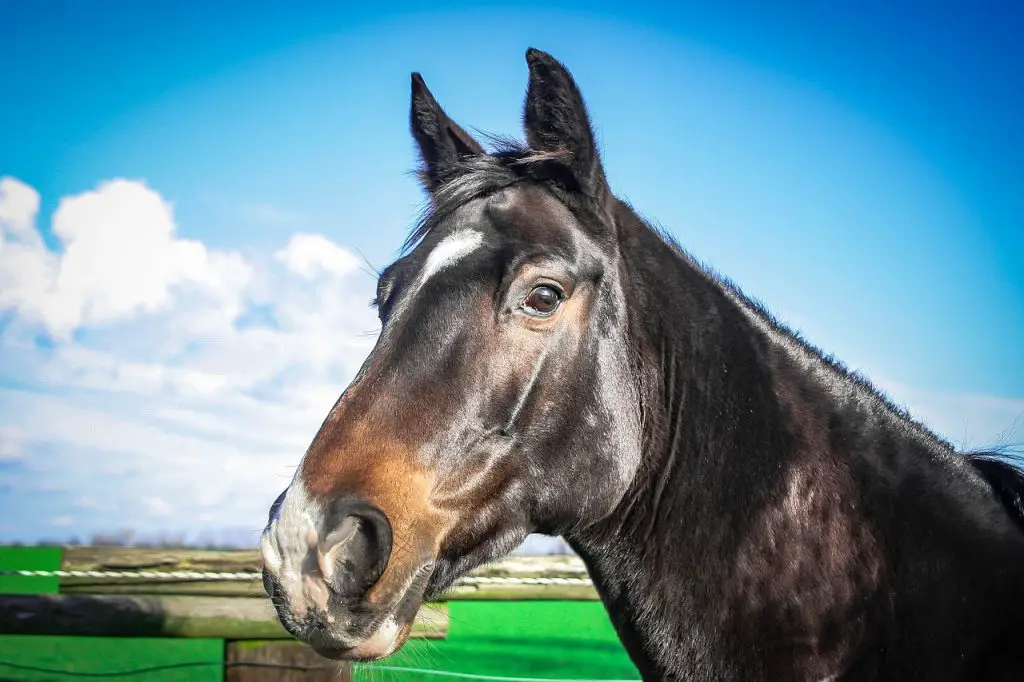Last Updated on February 25, 2022 by Allison Price
Changes in the tempromandibular joints (TMJ), could lead to pain, poor performance, and behavior problems in horses.
Or not.
The small joint on the jaw is responsible for mammals opening and closing their mouths. James Carmalt MA, VetMB. MVetSc. PhD, FRCVS. Dipl. ABVP. Horses can also experience wear-and-tear in their TMJs as they age. However, this doesn’t necessarily mean that these alterations are affecting their health.
Carmalt stated that “We have been searching for clinical signs of TMJ disease (specifically OA in horses) for 15 years and we have only confirmed two cases.”
Confirmed Cases
Carmalt stated that a Tennessee Walking Horse mare aged 18 was experiencing frequent episodes of colic, sometimes as many as eight per year. She was also difficult to ride, fighting the bit, and dropped food (“quidding”) She had lost 60 kg (140 pounds) over a year, and she was sensitive to touch one side of her face. She could hear clicking from her jaws when she chewed. Carmalt’s team administered corticosteroids to her TMJs. The horse’s problems were resolved for several months before having to be injected again. Carmalt scanned her head with an MRI, and confirmed that the mare had suffered from arthritic joint degeneration.

Carmalt said that a 8-year-old Thoroughbred cross dressage horse was showing unpredictable and explosive behavior under saddle, “to the point where the owner didn’t wish to ride him.” The behavior was improved after his team used local anesthesia to block the horse’s TMJs (to relieve pain).
Carmalt stated that a computed tomography scan (CT), showed bilateral cysts on both sides of the mandibular cone. These were surgically treated. “He has not shown any signs of abnormal behavior since and has returned to work.”
40% Horses have TMJ Changes
Carmalt stated that TMJ degenerative changes are quite common in older horses. Carmalt examined CT scans of over 1,000 horses’ heads and found that almost 40% of them had TMJ problems. This is more common as the horses age. However, the owners of horses said that they have never seen any signs of TMJ-related issues despite these changes.
He said that it is not clear if this means horses aren’t experiencing pain from TMJ changes.
Carmalt said that horses are prey animals and can hide these types of things. You can also find horses that have broken teeth, but they are still eating and drinking normal. The only way to tell if the teeth are fractured is by looking into their mouths. If that were to happen to us humans, we would be in pain. It’s difficult to say. Regardless, it is not difficult to believe that TMJ pain in horses is more common than we realize. This joint may be the root cause of many horses who are’rein-lame.
The Catch-All’ Diagnosis
Carmalt stated that it is difficult to prove TMJ disease. It’s therefore easy to diagnose TMJ disease when other symptoms are not available. “It’s nebulous so nobody can prove it wrong.”
He said that steroid injections in the joint can resolve performance or clinical signs even if the TMJ is not the cause of the problem.
He said that there are structures around the joint that can respond to a steroid injecting into them. These include the cranial nerves and the temporohyoid, paracondylar, and soft tissues. Injecting steroids into the joint can cause them to be distributed systemically (into other horses). You can have great luck and be convinced that the TMJ is the problem. However, it’s also possible that there’s no disease.
Blindly injecting the TMJ: A bad idea
Carmalt stated that injecting the TMJ to fix other problems is not a wise idea due to its structure. He said that the TMJ’s fibrocartilage is fundamentally different from other joints and that we don’t know how it reacts to steroids. “Nobody has done that work yet, not even humans.
He said that vets inject joints sometimes because they want to provide a quick fix for clients. It’s important to remember that steroids can affect the normal housekeeping of articular cartilage. Side effects are possible with any treatment. If you don’t feel the need to inject a particular joint, then don’t. “
Carmalt stated that it is better to have a clear diagnosis than “blaming” TMJ. He said that the TMJ is only one aspect of the whole body and that it must be functioning properly for optimal performance. A horse must be properly cared for. Veterinarians must rule out issues such as hock pain, arthritis in back, neck problems, and so forth. Objective lameness tests can be used to identify issues that are not related to TMJ.
The team that evaluates a problem horse should start from ground zero. They must look at the history of the horse, assess the horse’s movement from the ground, under saddle or tacked, and then address any issues before being pushed into the corner to inject the TMJ. This is not in the best interests of the horse.



